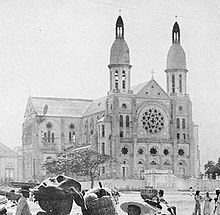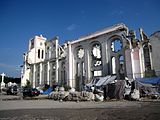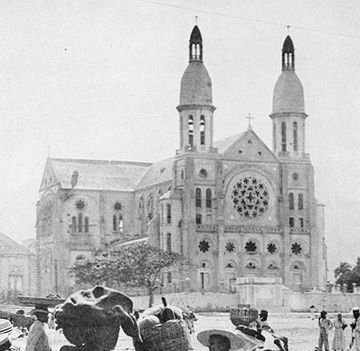The Cathedral of Our Lady of the Assumption (French: Cathédrale Notre-Dame de L'Assomption), often called Port-au-Prince Cathedral (French: Cathédrale de Port-au-Prince), was a cathedral in Port-au-Prince, Haiti. Built between 1884 and 1914, it was dedicated on December 13, 1928, and became the cathedral church of the Roman Catholic Archdiocese of Port-au-Prince.[1] The cathedral was destroyed in during the devastating 2010 Haiti earthquake.
| Cathedral of Our Lady of the Assumption | |
|---|---|
 Cathedral before 1924 | |
| Religion | |
| Affiliation | Catholic Church |
| District | Archdiocese of Port-au-Prince |
| Rite | Roman Rite |
| Leadership | Mgr Guire Poulard, Archbishop of Port-au-Prince |
| Year consecrated | 1928 |
| Status | Destroyed (2010) |
| Location | |
| Location | Port-au-Prince, Haiti |
| Geographic coordinates | 18°32′56.6″N 72°20′19″W |
| Architecture | |
| Type | Cathedral |
| Groundbreaking | 1884 |
| Completed | 1914 |
Before its destruction, the cupola of the north tower of the cathedral served as the front lighthouse of a pair, guiding mariners into Port-au-Prince harbor.[2]
Destruction
The roof and the towers flanking the main entrance collapsed in the 2010 earthquake, although the lower parts of the walls remain standing.[3][4] The earthquake also destroyed the nunciature and the archdiocesan offices, killing Archbishop Joseph Serge Miot instantly[5] and Vicar General Charles Benoit later.[6][7]
- Remnants of the cathedral after its collapse. The aerial photo was taken 2 days after the earthquake of Tuesday, 12 January 2010
- Remnants of the cathedral after its collapse
- Interior of the cathedral after its collapse
Reconstruction
In March 2012, the Archdiocese of Port-au-Prince, in collaboration with Faith & Form magazine and the Institute for the Safeguarding of National Heritage (ISPAN), a Haitian-government institution, launched an international design competition inviting the architects from all over the world to submit ideas that would inform the reconstruction of the cathedral.
Puerto Rican architect Segundo Cardona, FAIA from SCF Architects won the competition. He proposed to integrate and frame the facade of the old building, which survived the earthquake, with two new concrete towers, while the old nave, whose pillars also partially survived, will be transformed into a covered courtyard. The religious ceremonies will take place at the level of the current transept under a vast room surmounted by a dome, underneath which will be the altar. The new design allows for a capacity of 1,200 faithful (capacity which can be raised to 600 additional persons thanks to the use of the covered yard). The interior of the new cathedral will be marked by the creative and abundant use of natural light, as the supply of electricity in Port-au-Prince is intermittent and expensive.
"The winning design — [is] a modern interpretation of the traditional architecture of a cathedral [...]. Cardona’s other significant works include the Coliseum of San Juan and the Puerto Rico Pavilion built for the 1992 World Expo in Seville, Spain."[8][9]
The cathedral remains in ruins as of 2021.[10]
See also
References
External links
Wikiwand in your browser!
Seamless Wikipedia browsing. On steroids.
Every time you click a link to Wikipedia, Wiktionary or Wikiquote in your browser's search results, it will show the modern Wikiwand interface.
Wikiwand extension is a five stars, simple, with minimum permission required to keep your browsing private, safe and transparent.



